For some ultralightweight enthusiasts, the best camping towel is the dirty t-shirt they've been wearing all day. However, for those of you who prefer to not smell like a festering onion, a quick-dry towel is an excellent addition to your camping kit – that is, as long as it actually dries you.
Camping towels don't exactly have the best reputation. Using one can feel like trying to dry yourself with a wet paper towel. And if left in the bottom of your bag damp, it can easily end up smelling like mildew mixed with regret.
As much as they try, they'll never dry you as well as a traditional towel. But when faced with the alternative of trying to fit the latter into your backpacking rucksack, let alone carrying it up a mountain, this is a small price to pay.
Even if you're car camping and have plenty of space, a camping towel will dry much quicker than a traditional towel, especially if it’s made of microfibre (a very fine synthetic fibre).
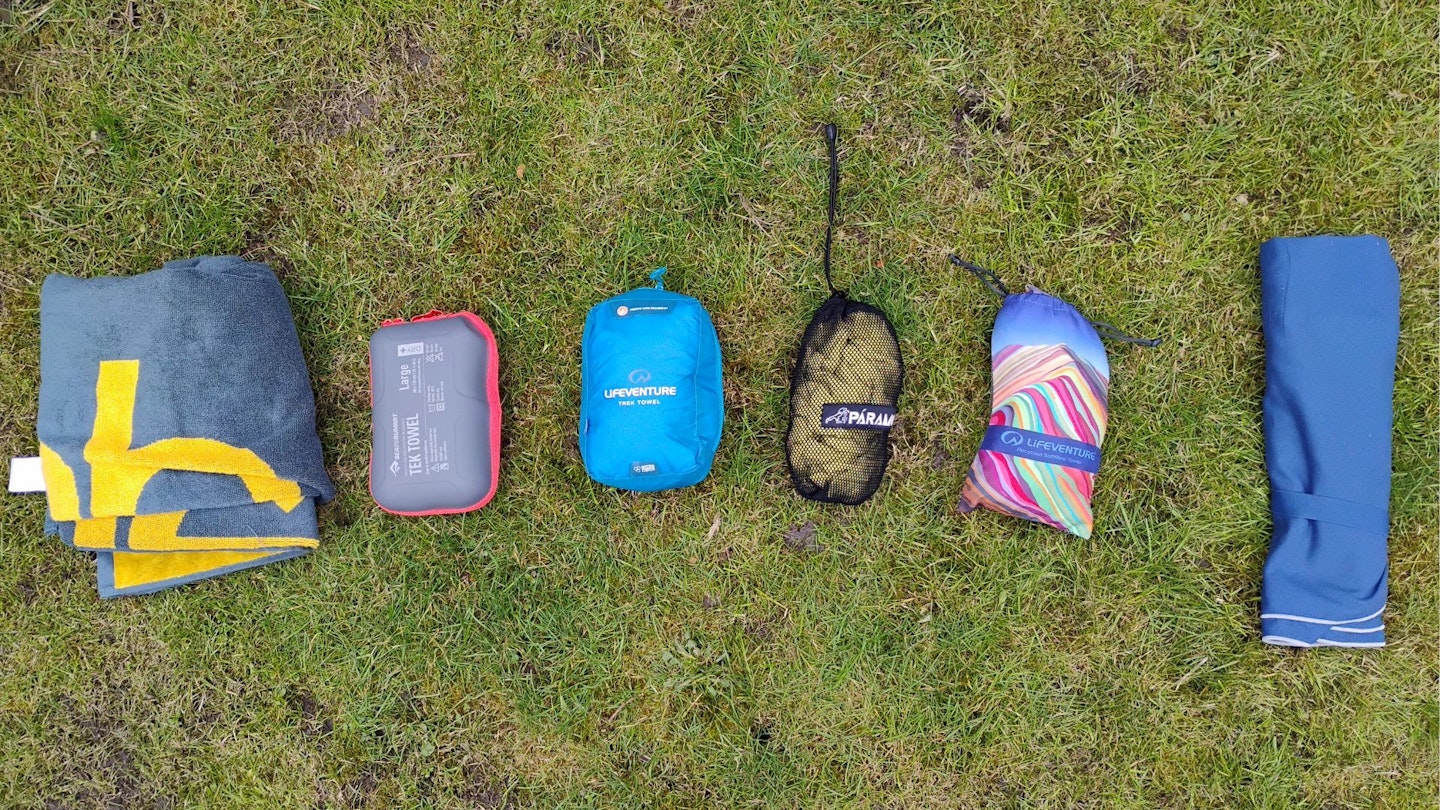
This all seems pretty uncontroversial. However, you might be surprised to hear that there’s more to a camping towel than meets the eye – something I’ve spent far too much time thinking about (bear with me).
You might imagine camping towels existing on a spectrum: on the one end, there are heavy and absorbent towels, like the dryRobe beach towel. On the other, you have lightweight microfibre towels like the Lifeventure SoftFibre, which are less absorbent and comfortable, but quick to dry.
Yet some towels, like the Sea to Summit Tek or Paramo Expedition, deny this easy categorisation: they manage to be lightweight yet absorbent, or comfortable yet quick-drying.
These technical towels are ideal for multi-day backpacking trips or wild camping, while classic microfibre towels are better suited for laid-back beach camping.
But what exactly is the difference, and which towel is best for your particular use? Read on to discover the LFTO team’s tried and tested list of top six camping towels for 2025.
How we tested the best camping towels
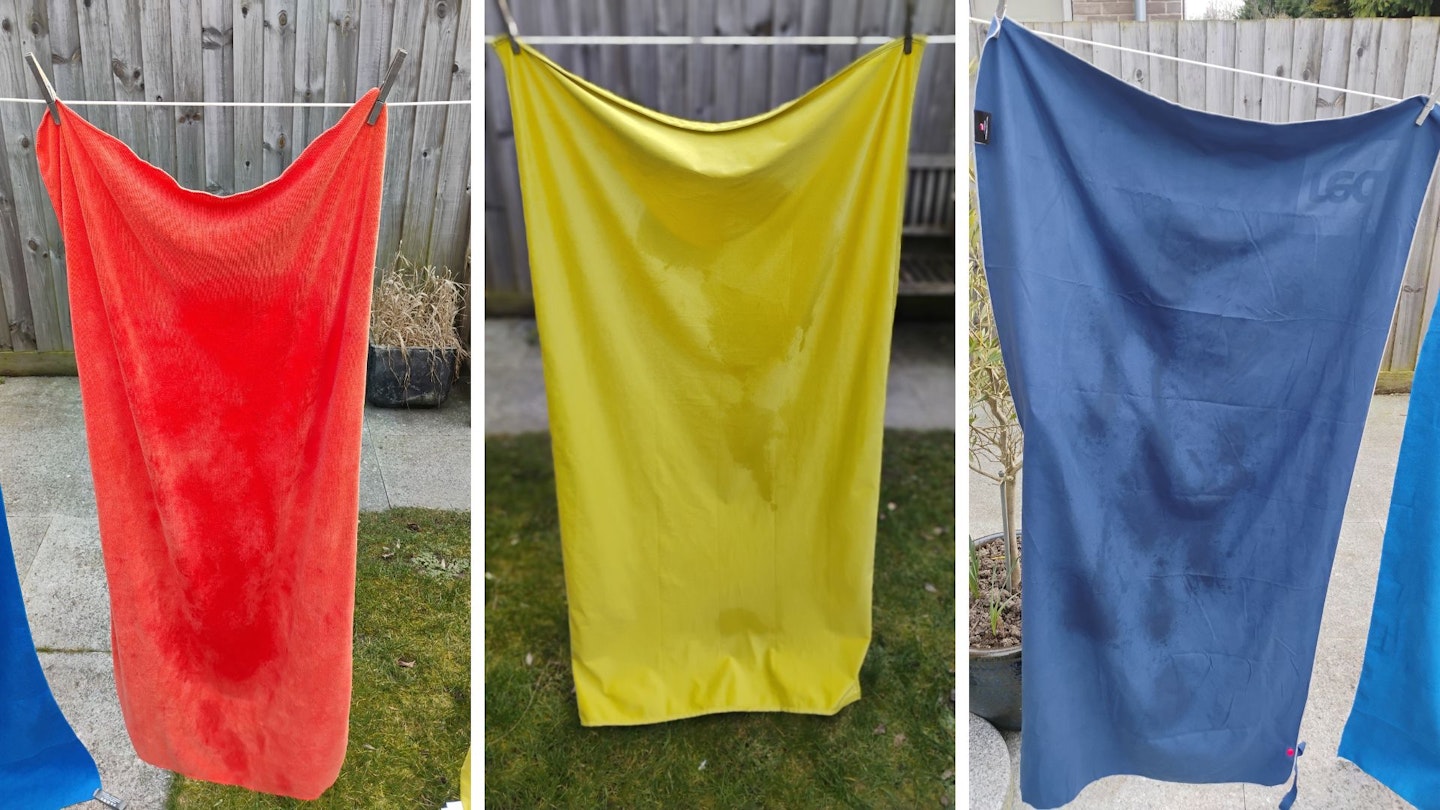
The LFTO team is made up of outdoor gear experts with years of experience drying themselves with camping towels. We carefully curated this product selection to suit a wide range of needs, ensuring there's something for everyone.
The reviews in this list have been written by digital writer Evie Nichols, with each one informed by thorough, real-life tests performed over several months at the start of 2025.
Brands are quick to claim how fast their camping towels dry, but we wanted to put those claims to the test. To measure drying speed, we added the same amount of water to each towel and weighed them at regular intervals. The towels that returned to their original weight the fastest earned the title of quickest to dry.
We also carefully examined how absorbent each camping towel is, weighing this up against their weight, comfort and value for money.
Read more general info about how we test HERE.
Our shortlist: Six of the best camping towels for 2025
Best in test: Paramo Expedition Towel
Best for absorbency: Sea to Summit Tek Towel
Best for eco-camping: Lifeventure SoftFibre Recycled Towel
Best camping towels reviewed:
The Paramo Expedition Towel is cleverly designed. It's quick to dry, lightweight and compact – perfect for multi-day adventures.
This towel is made from 100% polyester, using Nikwax Parameta S Light. After trawling through the brand's website, the meaning of this still mystifies me, but it's clear that this towel is actually quite unique.
It's completely smooth on one side, but the other is slightly textured. You dry yourself with the textured side, while the water is supposed to spread out on the other side, evaporating quickly.
The proof is in the pudding – in my test, this towel was the quickest to dry. It had returned to its starting mass after 2.5 hours.
As camping towels go, this one dries you pretty well. The textured side absorbs water effectively. It's very soft and feels nicer than smooth microfibre.
Plus, the mesh sack is handy for drying on the move, helping to prevent that dreaded damp towel smell.
It's the most compact and the lightest out of all of the towels I tested, but there's a sacrifice in size. It's far wider than it is long, so it'll wrap around you several times but won't cover much.
Overall, the Paramo Expedition Towel is an excellent choice for lightweight adventures, outperforming classic microfibre alternatives. But if you're car camping, a larger towel might be more comfortable.
Pros
- Very quick to dry
- Absorbs water pretty well
- Super compact
- Very lightweight
- Highly breathable mesh sack
Cons
- Only small sizes
- Shows dirt easily
| RRP: | £25 (large) |
| Pack size: | 13cm long x 7cm diameter (large) |
| Size tested: | 140cmx80cm (large) |
| Size range: | Compact or large |
| Weight: | 212g / 7.5oz (large) |
| Material: | 100% polyester |
- Hanging loop for drying
- Sack made entirely from mesh
If you're looking for a towel that prioritises comfort and absorbency, the Sea to Summit Tek Towel is a good choice.
One particularly handy feature is the snap-on hanging loop, which can be attached to backpack straps or washing lines. This makes it more versatile than towels that require a hook or peg.
By far though, the standout feature of this towel is how absorbent it is. Made from an 80/20 blend of polyester and nylon, it dries you very well. Its textured surface feels soft and pleasant against the skin.
However, its impressive absorbency comes with a trade-off: slower drying time. In my test, the Tek Towel still hadn’t returned to its starting mass after three hours, lagging behind quicker-drying options like the Paramo Expedition and Lifeventure SoftFibre.
My large version actually felt relatively small (60x120cm), but surprisingly heavy (252g). When saturated, it becomes significantly heavier due to its high absorbency.
Overall, if drying time is important to you, this probably isn't the best camping towel. But if you want a comfortable towel that dries you effectively, while still being pretty lightweight, then it's your best bet.
Pros
- Super absorbent
- Comfortable texture
- Handy snap-on loop
- Very good value
Cons
- Heavy for such a small towel
- Doesn't dry very fast
- Storage pouch is unecessarily bulky
| RRP: | £23 (large) |
| Size tested: | 60x120cm (large) |
| Size range: | XS to XL |
| Material: | 80% polyester, 20% nylon microfiber |
| Weight: | 252g / 9oz (large) |
| Pack size: | 20x12cm (large) |
- Snap-on hanging loop
- Carrying case with a zip
The Lifeventure SoftFibre is by far the most stylish towel of the bunch. And it performs well, too.
In testing it came out as the second quickest to dry, but it was very close. It’s also pretty lightweight and very large (285g for the giant size, which is 150x90cm).
Like the Red Equipment towel, it’s treated with odour control. This seems to work well in the short-term. Over the few weeks that I’ve tested it, it's remained fresh.
This is by far the most eco-friendly towel in this review. Lifeventure claims that the SoftFibre towel is fully recyclable, as it's made from a blend of recycled bottles (66%) and polyester (34%) – pretty impressive.
On the flipside of this, this towel isn't the most absorbent. However, like the other camping towels in this review, it’s large enough for this not to be a major issue, as you just end up using more surface area. And since it’s so quick to dry, this won’t really be a problem.
It's worth noting that this towel is very smooth to touch, which won’t suit everyone.
Overall, the Lifeventure SoftFibre is a very good choice for camping, outperforming most of the other towels in this test in drying speed – although it’s not the most absorbent. But it gets bonus points for eco-credentials.
Pros
- Very quick to dry
- Odour-resistant treatment
- Lightweight yet large
- Sustainable materials
Cons
- Not certain how long odour-reistance will last
- Smooth texture
| RRP: | £21.99 / $28.54 |
| Material: | 34% polyester, 66% recycled plastic bottles |
| Size tested: | 150x90cm (giant) |
| Size range: | Pocket, large, extra large, giant |
| Weight: | 285g / 10oz (giant) |
| Pack size: | 24x14x10cm |
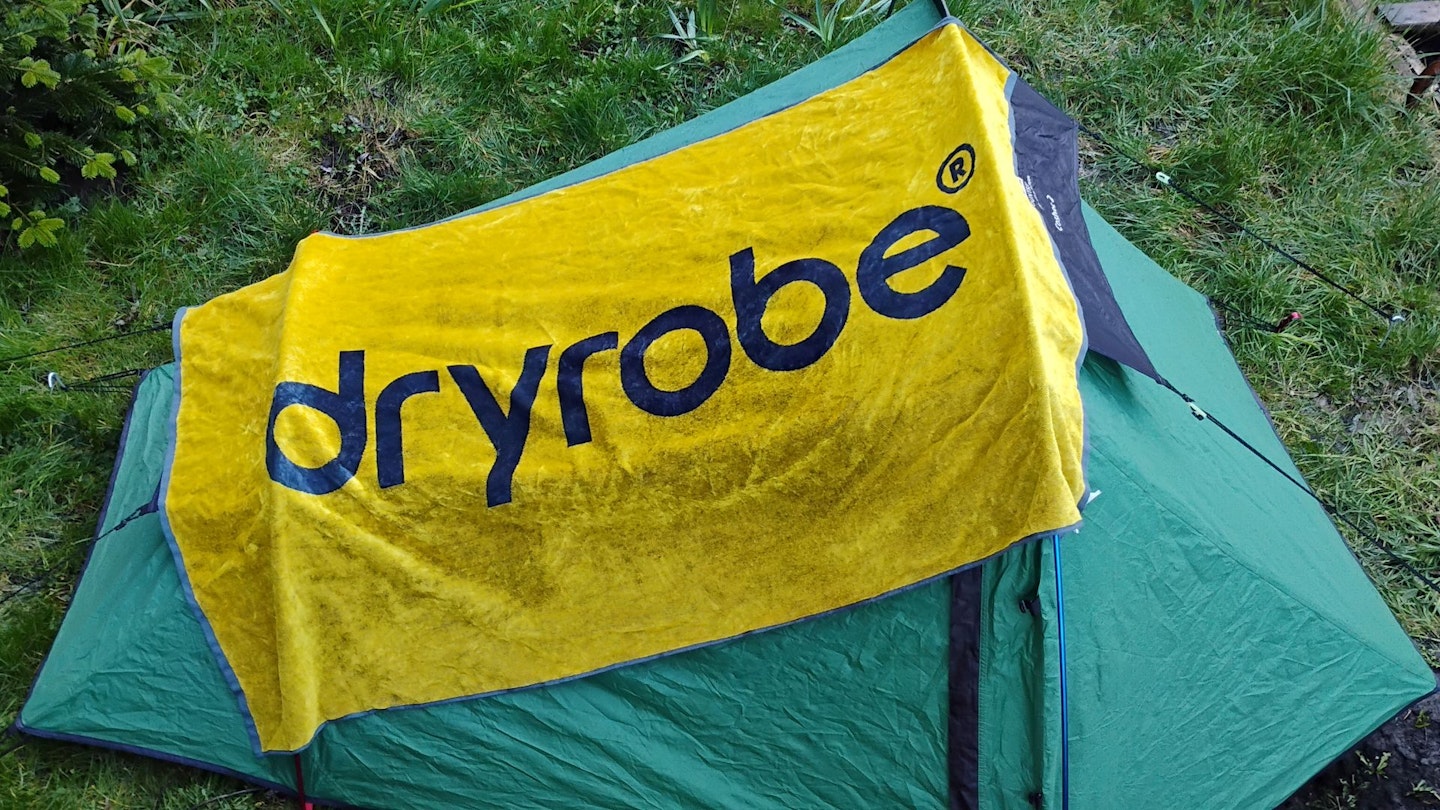 LFTO
LFTOdryrobe.com
The dryrobe Beach Towel positions itself as a 'premium' towel for watersports. Like most conventional towels, it's made from 100% cotton.
Unsurprisingly, this was the slowest to dry in our test. Compared to the other towels, it's very heavy (755g) and bulky.
Rather than comparing with lightweight camping towels, the most interesting question here is whether the dryrobe Beach Towel outperforms a bath towel for use at the beach or on a campsite.
The material is much thinner than a bath towel, but dries quicker and picks up less sand. It's generously sized for sunbathing and provides plenty of coverage for changing underneath. It's not plush, but feels very soft and velvety.
However, I found that it wasn't as absorbent as I'd hoped. In fact, water actually beads on the surface of this towel. Fortunately, it's large enough to still dry you well.
Despite this, the dryrobe Beach Towel still outperforms a traditional towel for beach use. It won't dry as quickly as a microfibre towel, though.
Pros
- Soft feel
- Large enough to dry anyone well
- Sand won't get caught in it
Cons
- Could be more absorbent
| RRP: | £40 |
| Size tested: | 100 x 180cm |
| Pack size: | |
| Material: | 100% cotton |
| Weight: | 755g / 1lb 11oz |
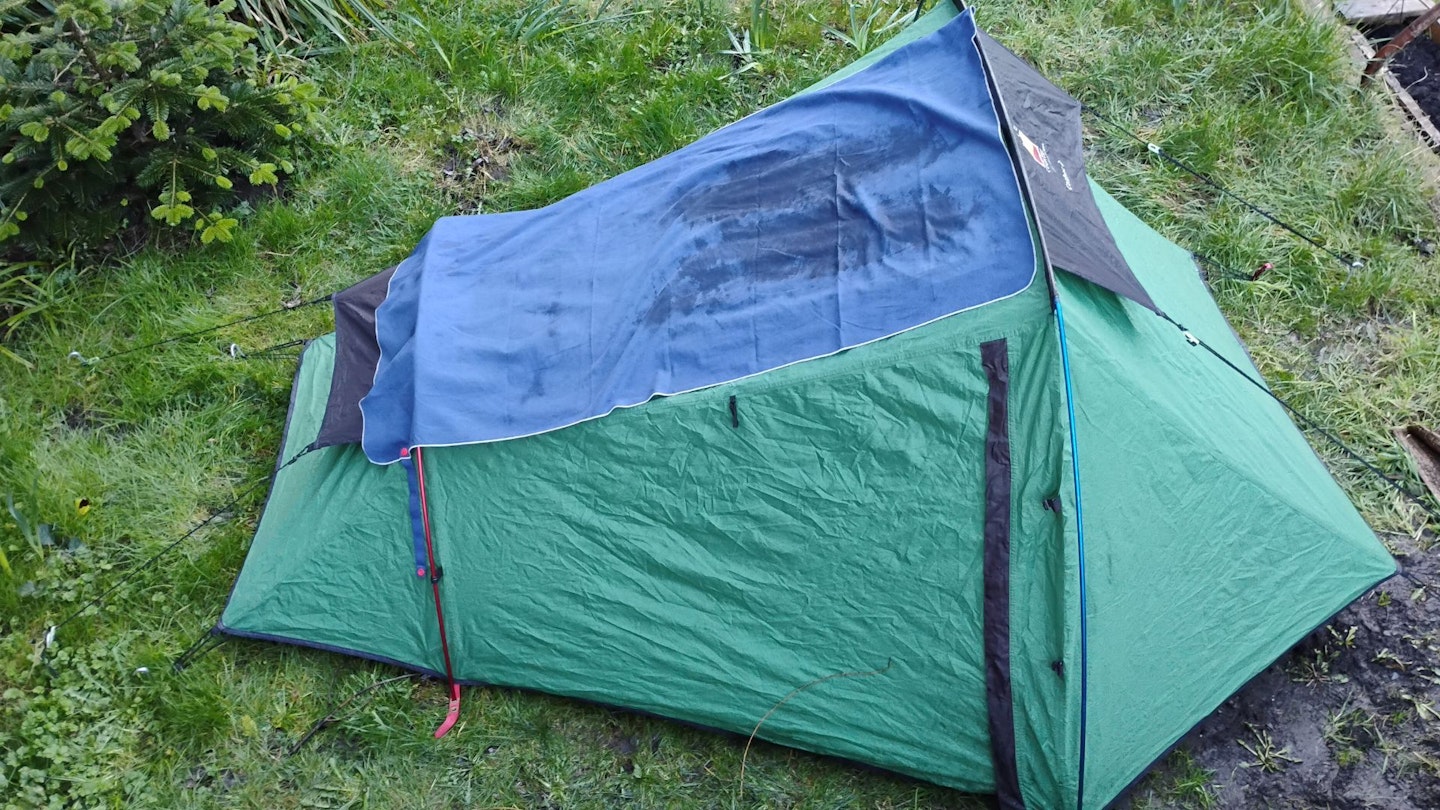 LFTO
LFTOred-equipment.co.uk
The best feature of the Red Equipment Microfibre towel is its size to weight ratio. It’s super lightweight (240g) but very large (80x150cm).
This makes it ideal for taking to the beach. And it won’t trap any sand, as it’s made of smooth microfibre (80% polyester, 20% polyamide).
Red Equipment states that it has anti-bacterial and anti-odour fabric. While I had some scepticism about this at first, I found that it does actually remain pretty fresh, even when stored wet in a plastic bag.
The downside is that it’s not very quick to dry, performing average in the drying test. It’s also not very absorbent. But like the dryrobe towel, it’s large enough for this not to be much of an issue.
The Red Equipment Microfibre towel doesn’t come with a bag and compared with the others in this test, it’s quite bulky, but it packs down to a fraction of the size of a standard towel.
It has a very smooth feel to it, which might divide opinion. I personally don’t mind this, but some people might prefer more texture.
Overall, the Red Equipment Microfibre towel is a good choice for beach and camp trips. It’s not as luxurious as the dryrobe Beach Towel, but is definitely quicker to dry, more compact and far lighter.
Pros
- Very good size to weight ratio
- Large enough for the beach
- Pretty odour-reistant
Cons
- Could be more absorbent
- Smooth microfibre texture might divide opinion
| RRP: | £26.95 |
| Size: | 80x150cm (large) |
| Material: | 80% polyester, 20% polyamide |
| Weight: | 240g / 8.5oz (large) |
- Detachable hanging loop
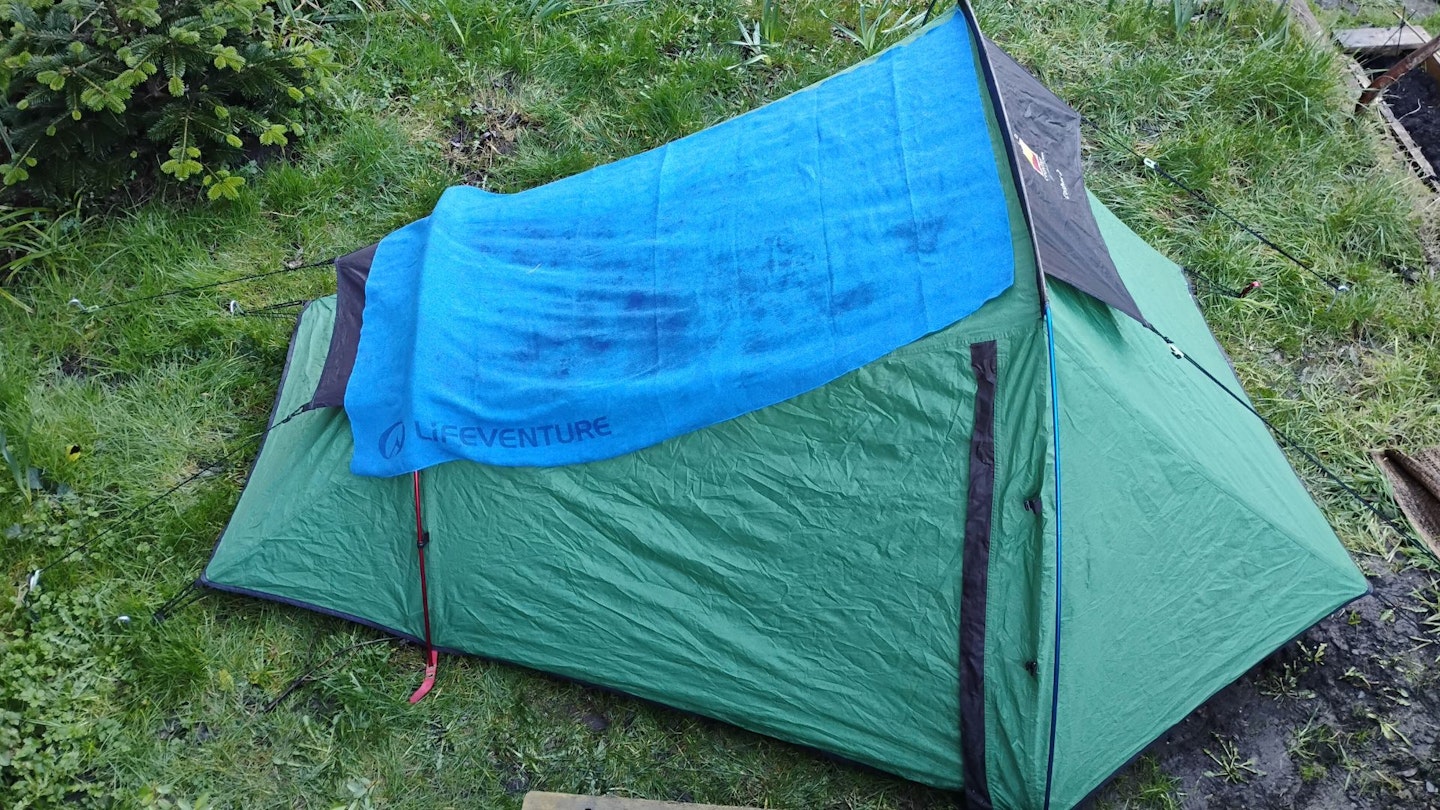 LFTO
LFTO
www.lifeventure.com
The Lifeventure MicroFibre towel dries you effectively, but takes a little longer to dry itself. It's the second-heaviest option in this list.
Surprisingly for microfibre, it actually feels quite similar to a normal towel. It’s more rough to touch than smooth microfibre, but still comfortable against your skin. Made from 90% polyester and 10% nylon, it’s very effective at drying you.
This towel performed about average in the drying speed test, but we’re not surprised as it’s more absorbent.
A bonus feature is the Polygiene odour control, which seems to work well in the short-term.
The label can be used as a hanging loop, which is quite nifty. It comes with a carrying pouch, which isn’t very breathable, as it has thick mesh on one side. On the plus side, it’s made of durable materials, so it's unlikely to rip.
Overall, this is a great option if you’d like something that’s as close as possible to a normal towel, while still being a camping towel.
Pros
- Dries you very effectively
- Pretty quick to dry
- Odour-resistant in the short-term
Cons
- Carrying pouch isn't very breathable
- Long-term odour resistance unknown
| RRP: | £27.99 (giant) |
| Size tested: | 150x90cm (giant) |
| Size range: | Large, X-large, giant |
| Material: | 90% polyester, 10% nylon |
| Weight: | 392g / 13.8oz (giant) |
| Pack size: | 20x12x8cm (giant) |
- Hanging loop
- Durable carrying pouch
What should you look for when buying a camping towel?
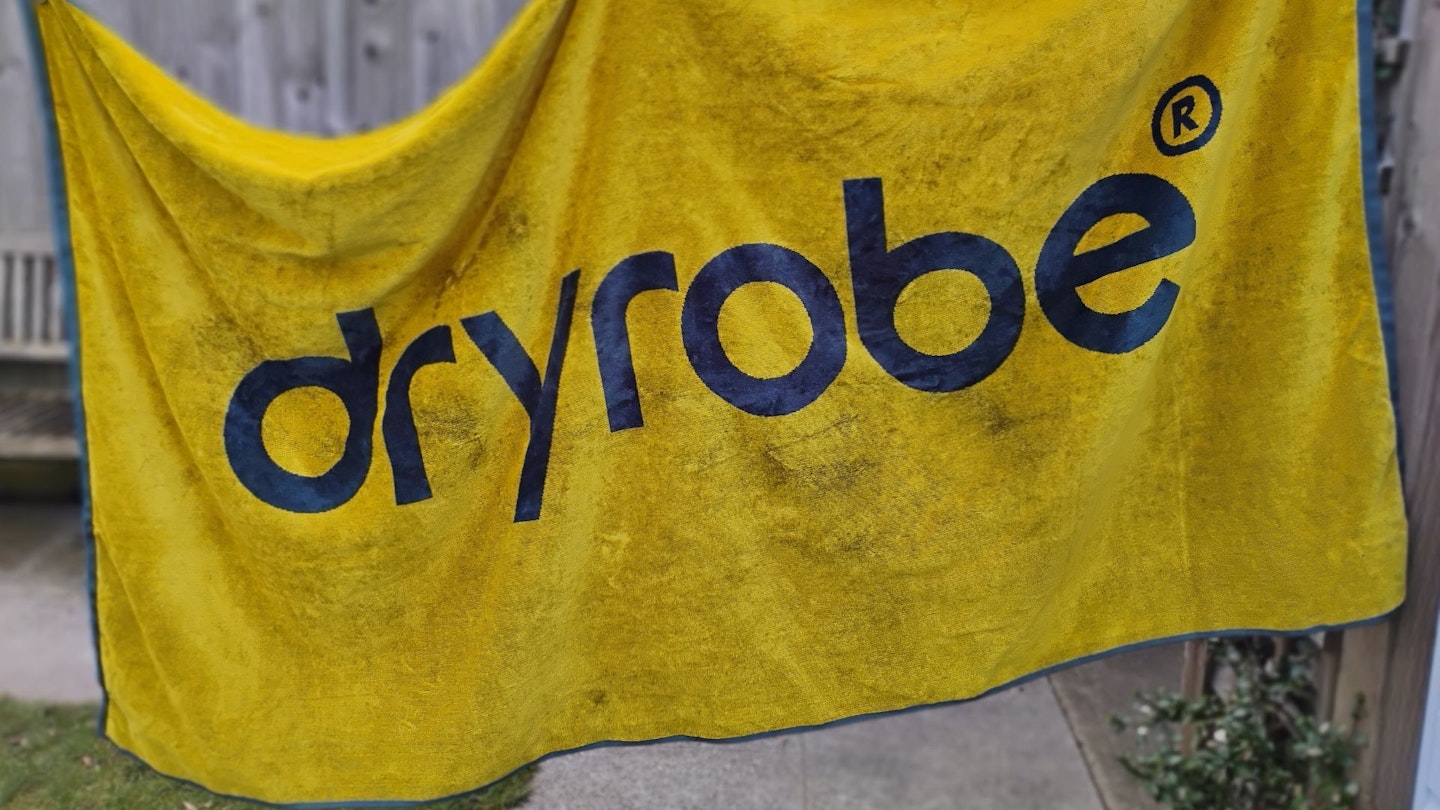
Arguably, the most important things are drying time, pack size and weight. These are the main reasons why you'd buy a camping towel over a normal towel: you need something lightweight that dries quickly.
Drying time
Drying time can be tricky to judge without firsthand use, but you can get some indication from a towel's texture. Microfibre camping towels have varying textures: some are very smooth, while others feel more similar to a conventional towel.
In our drying speed tests, we found that, unsurprisingly, the more similar to a conventional towel it feels and looks, the slower it’ll dry. If you want something that’s quick to dry, a smooth microfibre towel is a safe bet.
Texture
But consider what kind of texture you find comfortable. Some people don’t like the smooth feeling of some microfibre. If so, it’s best to opt for a textured towel, like the Sea to Summit Tek or Lifeventure MicroFibre.
Weight
Opting for a textured towel may come with a trade-off in terms of weight, though, as often these materials are a little heavier. As a general reference, the most lightweight camping towels start at around 40g (for a really tiny towel). This can go up to around 400g for large microfibre towels, while beach towels weigh around 750g.
Size
Interestingly, the size of a camping towel doesn’t correlate with weight as closely as you might think. Some large towels, like the Lifeventure SoftFibre and Red Equipment Microfibre, are still pretty lightweight (less than 300g).
If you're going to be tight on space, a towel that packs down nice and small can be a huge asset. Many of the best camping towels pack down much smaller than ordinary towels, but how small you want them to go will depend on if you're car camping or wild camping.
Which type of camping towel is right for me?
Large, smooth microfibre towels are perfect for beach days. Although they’re not super absorbent, their surface area is big enough to still dry you well.
For backpacking trips, it's better to opt for a smaller but more technical towels, like the Paramo Expedition or Sea to Summit Tek towels. These are compact yet highly absorbent, ideal for saving space.
Generally, if you’re looking for something that’s super lightweight, you may have to sacrifice some comfort and absorbency. On the other hand, if weight isn’t really an issue, you could go for a more comfortable and absorbent towel.
Do camping towels work?
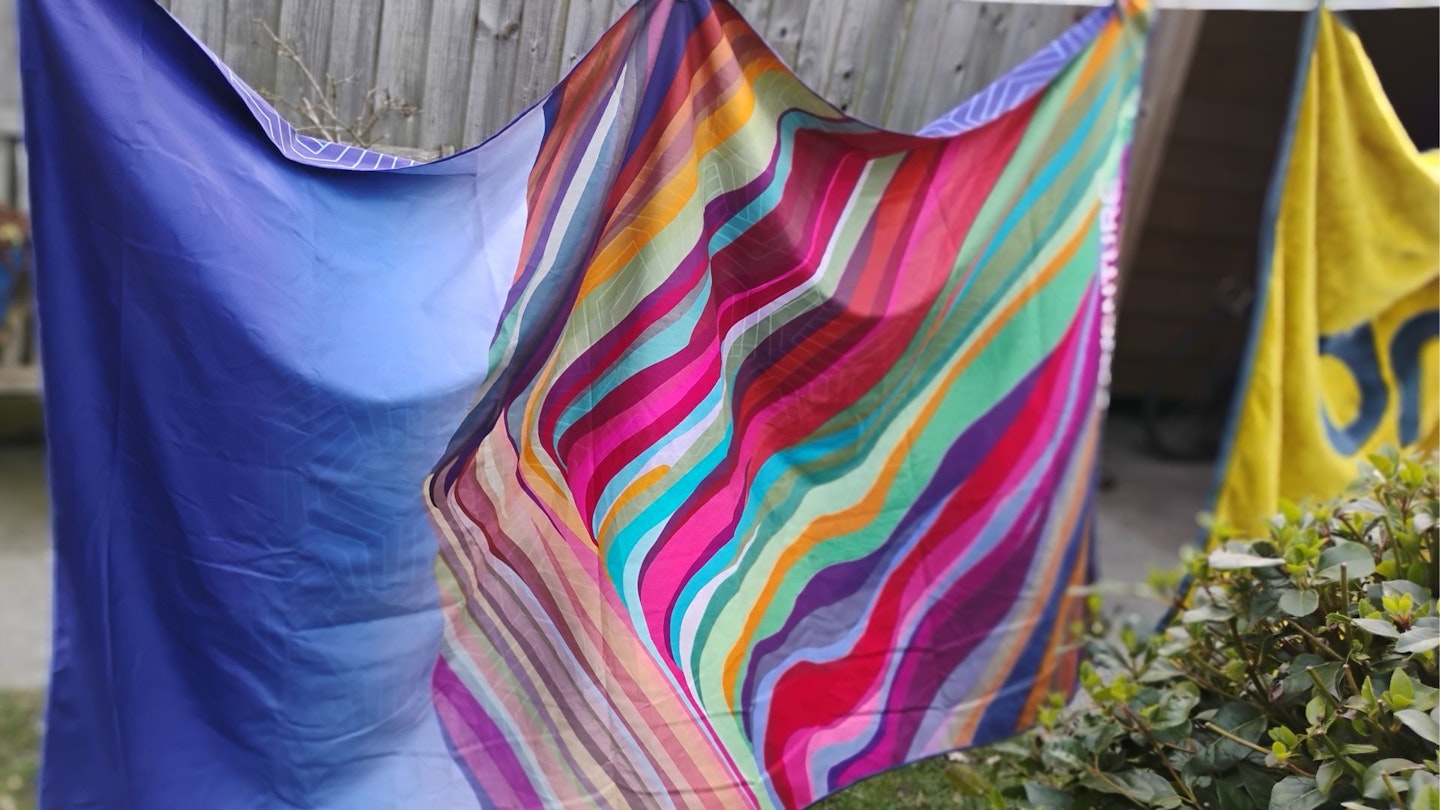
Camping towels, defined as towels that are made from microfibre, may not dry you as effectively as a conventional towel, but they’re undeniably quicker to dry after use.
Some camping towels work better than others. There are some which mimic the feeling of traditional towels, like the Lifeventure MicroFibre or the Sea to Summit Tek towel. These are the most effective at drying you, but weigh more than less absorbent alternatives.
Smooth microfibre towels, like the Lifeventure SoftFibre, are generally lighter, but slightly less absorbent – but we find they still do the job pretty well.
And it’s true: camping towels do dry quicker than conventional towels. Based on our tests of the towels in this review, we can confidently say that a microfibre towel will outperform a classic cotton towel in drying speed.
Are quick dry towels worth it?

The short answer is: yes. Even if you're car camping and space or weight isn't an issue, you'll find that a traditional towel dries much more slowly than a camping towel.
If you're planning a multi-day hike, a quick dry towel is a no-brainer. They're much lighter, more compact, and can dry on the outside of your rucksack.
They’ll probably stay fresher than traditional towels too, especially the ones with odour-resistant treatment.
Yes, they’re probably not as comfortable as a normal towel. And no, they won’t dry you as well. But these are minor scruples when you factor in the difference in weight and drying speed. As an experienced camper, I wouldn’t go camping without one.
How to pack towels for camping?

Firstly, make sure to choose a towel which doesn’t use up too much space. Buy a towel that’s specifically designed for camping or travel.
If space is limited, opt for a towel which comes in its own carrying pouch. This will probably help you to get it to a smaller pack size than if it's just loose in your bag. Try to find a breathable pouch to help prevent your towel from getting smelly.
Although it’s time-consuming, it’ll save space if you fold or roll the towel, rather than just squishing it into your bag.
Unless you enjoy the smell of mildew, it’s best not to pack a damp towel. If it’s still damp, you could hang it on the outside of your rucksack and let it dry in the breeze.
For more advice, read our article on how to pack for ultralight backpacking.
About the author

Digital writer Evie is equally happy on a boggy Peak District trail run or a multi-day Alpine hike and loves nothing more than being in high and remote places.
She's (attempted to) dry herself with many camping towels on hiking trips across Europe and beyond, to varying degrees of success. Personally, she likes a towel that's super lightweight and dries quickly – beyond that, she's not too fussed.



